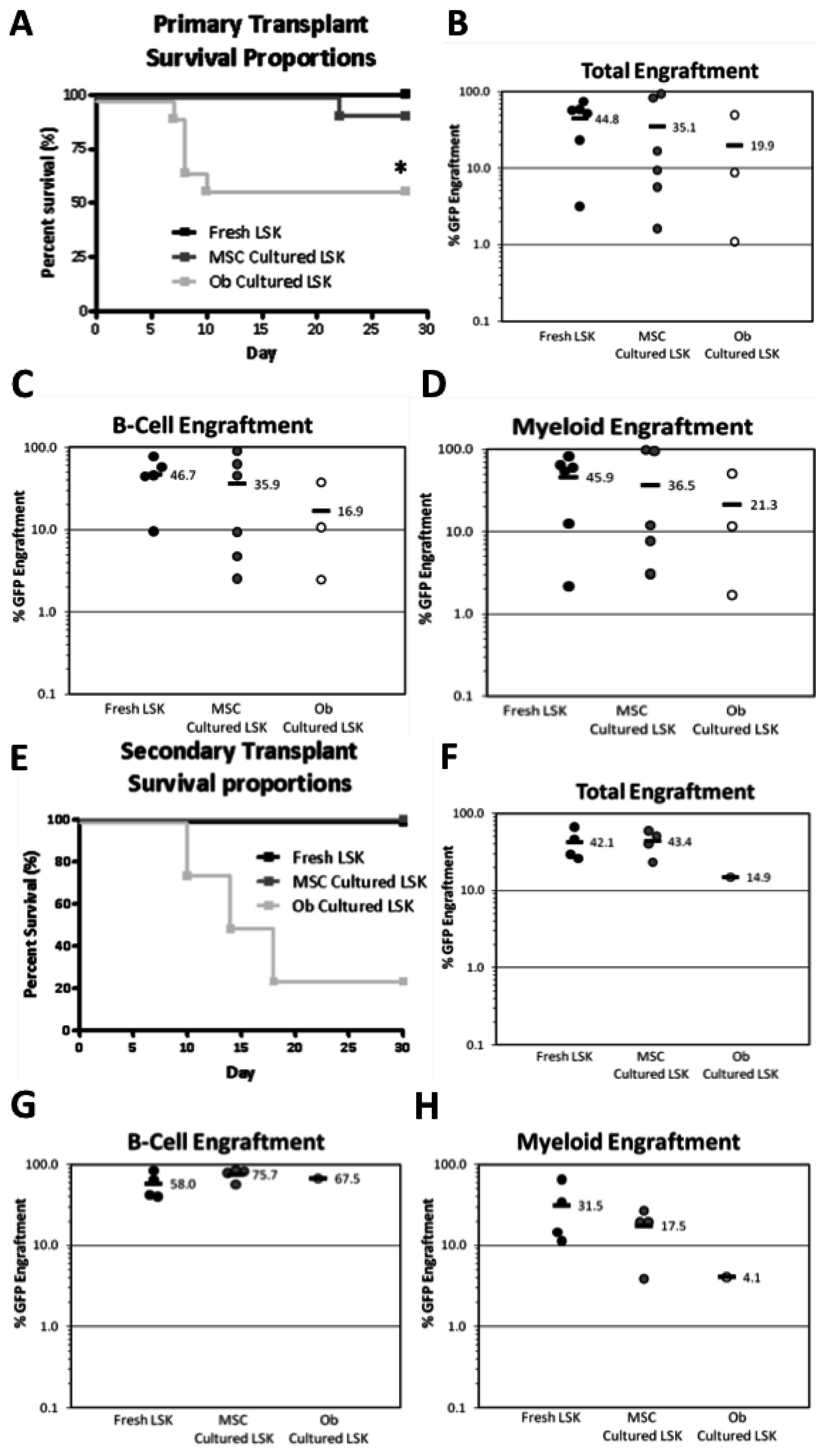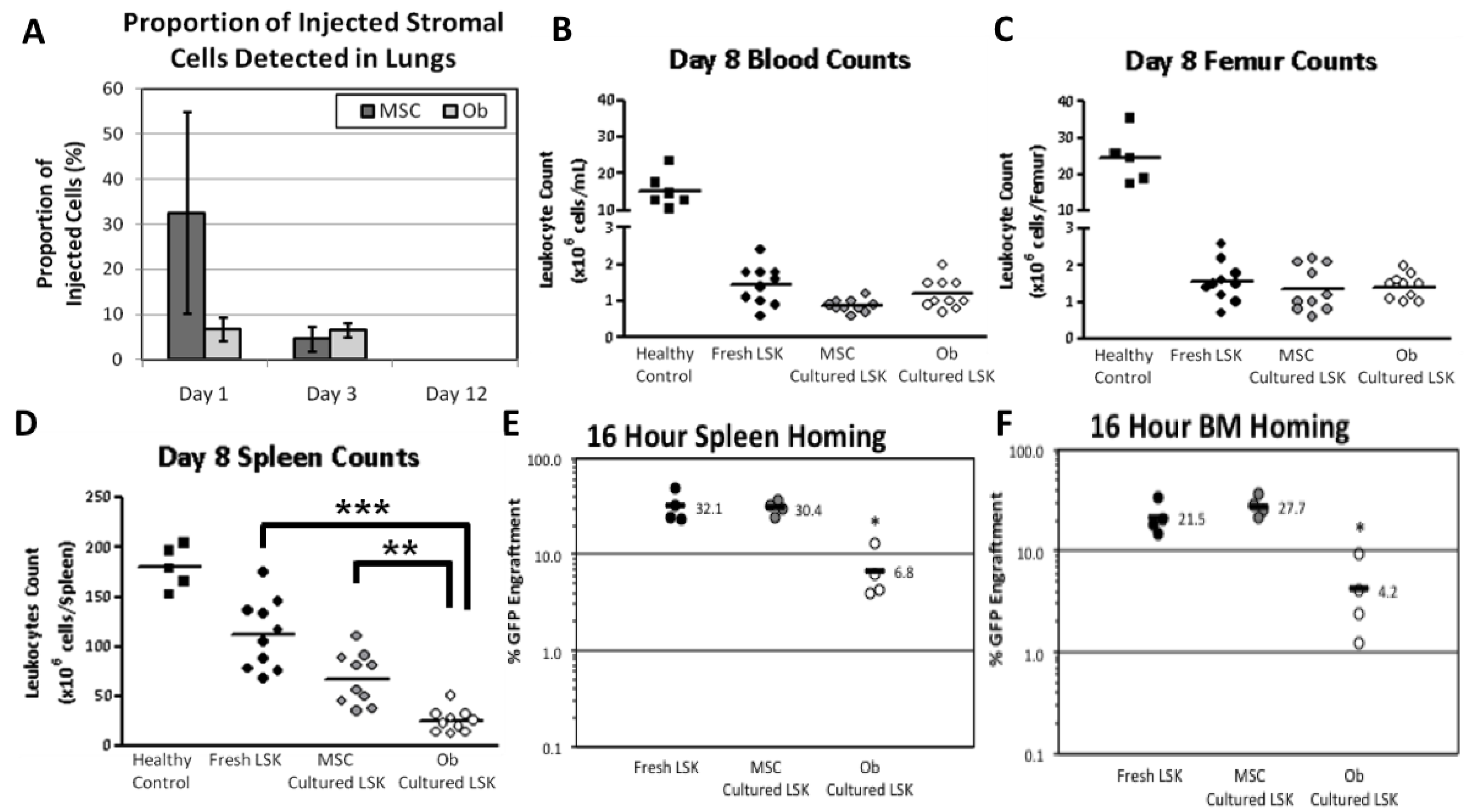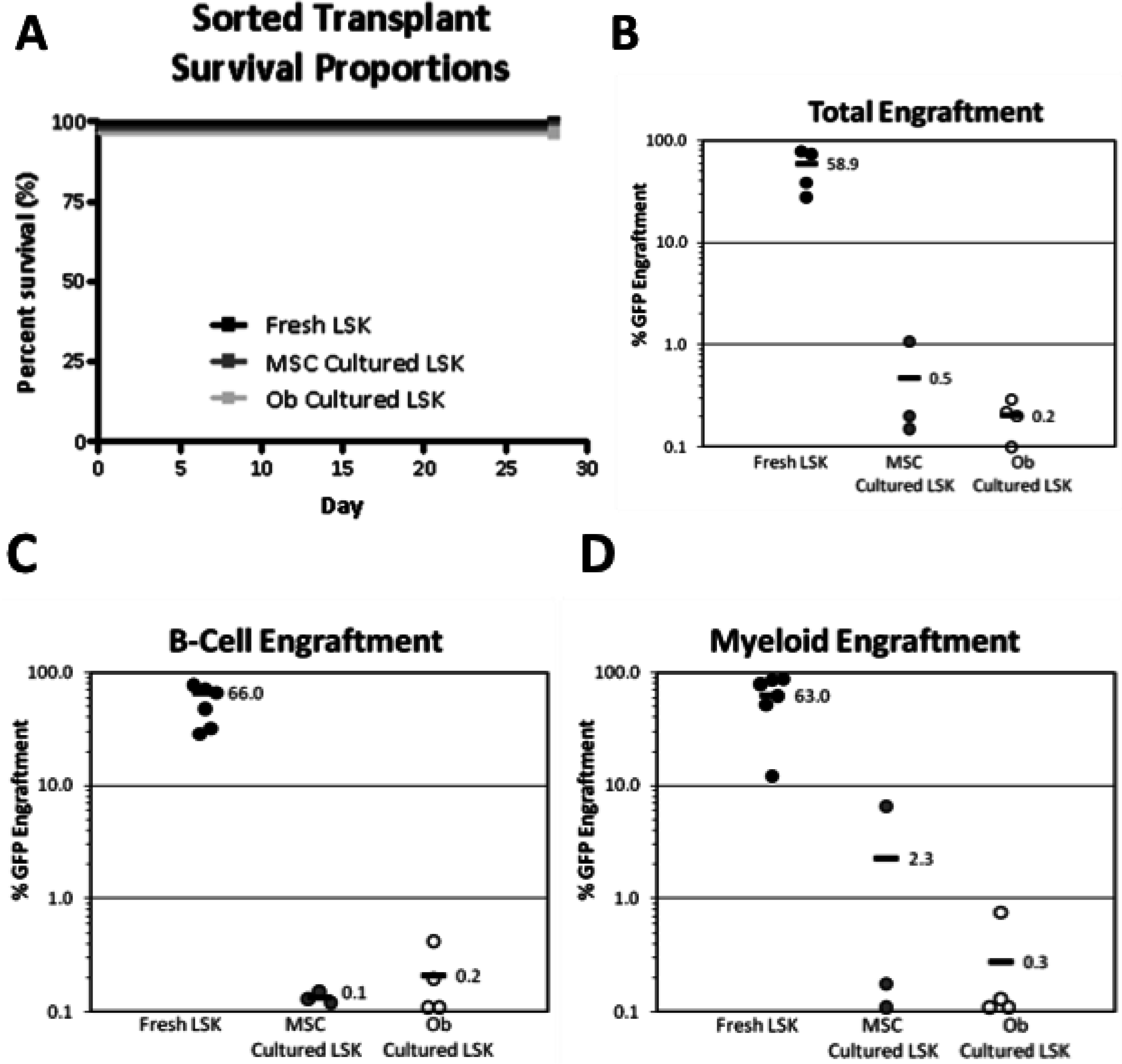Engraftment Outcomes after HPC Co-Culture with Mesenchymal Stromal Cells and Osteoblasts
Abstract
:1. Introduction
2. Experimental Section
2.1. Mice
2.2. Isolation of LSK and MSC Populations
2.3. Osteogenic Induction of Undifferentiated MSCs
2.4. Flow Cytometry
2.5. RNA Extraction and PCR
| Primer | Sequence | Fragment size |
|---|---|---|
| GAPDH-(F) | 5′-TGGTGAAGGTCGGTGTGAACG-3′ | 105 |
| GAPDH-(R) | 5′-CAATGAAGGGGTCGTTGATGGC-3′ | |
| RUN2X-(F) | 5′-CCACCTTTACCTACACCCCG-3′ | 89 |
| RUN2X-(R) | 5′-GGTGGCAGGTACGTGTGGTAGT-3′ | |
| Osterix-(F) | 5′-AGCTCACTATGGCTCCAGTCC-3′ | 21 |
| Osterix-(R) | 5′-GCGTATGGCTTCTTTGTGCCT-3′ | |
| Osteocalcin-(F) | 5′-TTCTGCTCACTCTGCTGACCCT-3′ | 22 |
| Osteocalcin-(R) | 5′-CCCTCCTGCTTGGACATGAA-3′ | |
| Angiopoietin 1-(F) | 5′-CAAATGCGCTCTCATGCTAA-3′ | 162 |
| Angiopoietin 1-(R) | 5′-ATGGTGGTGGAACGTAAGGA-3′ | |
| Angiopoietin 2-(F) | 5′-CCATCTTCTCGGTGTTGGAT-3′ | 194 |
| Angiopoietin 2-(R) | 5′-TCCAAGAGCTCGGTTGCTAT-3′ | |
| Stem Cell Factor-(F) | 5′-GCTACCCAATGCTGGGACTA-3′ | 207 |
| Stem Cell Factor-(R) | 5′-CCGCAGATCTCCTTGGTTT-3′ | |
| Jagged-1-(F) | 5′-AGTAGAAGGCTGTCACCAAGCAAC-3′ | 113 |
| Jagged-1-(R) | 5′-AGAAGTCAGAGTTCAGAGGCGTCC-3′ | |
| SDF-1-(F) | 5′-TGCCCTTCAGATTGTTGCACGG-3′ | 67 |
| SDF-1-(R) | 5′-ATTTCGGGTCAATGCACACTTGTC-3′ |
2.6. Co-Culture Assay
2.7. Haematopoietic Reconstitution Assays
2.8. Genomic DNA Extraction and Detection of GFP by qRT-PCR
2.9. Statistical Analysis
3. Results and Discussion
3.1. Characterisation of Murine LSKs and MSCs

3.2. Osteoblasts Preferentially Induce Haematopoietic Cell Expansion Relative to Undifferentiated MSCs

3.3. MSC-Cultured HSC Engraft in Primary and Secondary Transplants Recipients while Osteoblast-Cultured HSCs are Associated with Poorer Haematopoietic Engraftment

3.4. MSC and Osteoblasts are Trapped in the Lungs Shortly after Transplantation
3.5. Transplantation of LSK/Osteoblasts Co-Cultures Compromises Short-Term Splenic Reconstitution

3.6. Impairment of Homing Ability to the Spleen
3.7. Removal of Osteoblasts from Co-Cultures Prior to Injection is Required for Short-Term Reconstitution
4. Conclusions

Acknowledgments
Conflicts of Interest
References
- Atkinson, K.; Champlin, R.; Ritz, J.; Fibbe, W.; Ljungman, P.; Brenner, M. Clinical Bone Marrow and Blood Stem Cell Transplantation, 3rd ed.; Cambridge University Press: Cambridge, UK, 2004. [Google Scholar]
- Munker, R.; Lazarus, H.M.; Atkinson, K. The BMT Data Book, 2nd ed.; Cambridge University Press: Cambridge, UK, 2009. [Google Scholar]
- Gluckman, E.; Rocha, V.; Boyer-Chammard, A.; Locatelli, F.; Arcese, W.; Pasquini, R.; Ortega, J.; Souillet, G.; Ferreira, E.; Laporte, J.P.; et al. Outcome of cord-blood transplantation from related and unrelated donors. N. Engl. J. Med. 1997, 337, 373–381. [Google Scholar] [CrossRef]
- Eapen, M.; Rubinstein, P.; Zhang, M.J.; Stevens, C.; Kurtzberg, J.; Scaradavou, A.; Loberiza, F.R.; Champlin, R.E.; Klein, J.P.; Horowitz, M.M.; et al. Outcomes of transplantation of unrelated donor umbilical cord blood and bone marrow in children with acute leukaemia: A comparison study. Lancet 2007, 369, 1947–1954. [Google Scholar] [CrossRef]
- Hwang, W.Y.; Samuel, M.; Tan, D.; Koh, L.P.; Lim, W.; Linn, Y.C. A meta-analysis of unrelated donor umbilical cord blood transplantation versus unrelated donor bone marrow transplantation in adult and pediatric patients. Biol. Blood Marrow Transplant. 2007, 13, 444–453. [Google Scholar] [CrossRef]
- Rocha, V.; Cornish, J.; Sievers, E.L.; Filipovich, A.; Locatelli, F.; Peters, C.; Remberger, M.; Michel, G.; Arcese, W.; Dallorso, S.; et al. Comparison of outcomes of unrelated bone marrow and umbilical cord blood transplants in children with acute leukemia. Blood 2001, 97, 2962–2971. [Google Scholar] [CrossRef]
- Rocha, V.; Labopin, M.; Sanz, G.; Arcese, W.; Schwerdtfeger, R.; Bosi, A.; Jacobsen, N.; Ruutu, T.; de Lima, M.; Finke, J.; et al. Transplants of umbilical-cord blood or bone marrow from unrelated donors in adults with acute leukemia. N. Engl. J. Med. 2004, 351, 2276–2285. [Google Scholar] [CrossRef]
- Rocha, V.; Wagner, J.E., Jr.; Sobocinski, K.A.; Klein, J.P.; Zhang, M.J.; Horowitz, M.M.; Gluckman, E. Graft-versus-host disease in children who have received a cord-blood or bone marrow transplant from an HLA-identical sibling. N. Engl. J. Med. 2000, 342, 1846–1854. [Google Scholar] [CrossRef]
- Smith, A.R.; Wagner, J.E. Alternative haematopoietic stem cell sources for transplantation: Place of umbilical cord blood. Br. J. Haematol. 2009, 147, 246–261. [Google Scholar] [CrossRef]
- Takahashi, S.; Ooi, J.; Tomonari, A.; Konuma, T.; Tsukada, N.; Oiwa-Monna, M.; Fukuno, K.; Uchiyama, M.; Takasugi, K.; Iseki, T.; et al. Comparative single-institute analysis of cord blood transplantation from unrelated donors with bone marrow or peripheral blood stem-cell transplants from related donors in adult patients with hematologic malignancies after myeloablative conditioning regimen. Blood 2007, 109, 1322–1330. [Google Scholar]
- Migliaccio, A.R.; Adamson, J.W.; Stevens, C.E.; Dobrila, N.L.; Carrier, C.M.; Rubinstein, P. Cell dose and speed of engraftment in placental/umbilical cord blood transplantation: Graft progenitor cell content is a better predictor than nucleated cell quantity. Blood 2000, 96, 2717–2722. [Google Scholar]
- Askmyr, M.; Sims, N.A.; Martin, T.J.; Purton, L.E. What is the true nature of the osteoblastic hematopoietic stem cell niche? Trends Endocrinol. Metab. 2009, 20, 303–309. [Google Scholar] [CrossRef]
- Calvi, L.M.; Adams, G.B.; Weibrecht, K.W.; Weber, J.M.; Olson, D.P.; Knight, M.C.; Martin, R.P.; Schipani, E.; Divieti, P.; Bringhurst, F.R.; et al. Osteoblastic cells regulate the haematopoietic stem cell niche. Nature 2003, 425, 841–846. [Google Scholar] [CrossRef]
- Chitteti, B.R.; Cheng, Y.H.; Poteat, B.; Rodriguez-Rodriguez, S.; Goebel, W.S.; Carlesso, N.; Kacena, M.A.; Srour, E.F. Impact of interactions of cellular components of the bone marrow microenvironment on hematopoietic stem and progenitor cell function. Blood 2010, 115, 3239–3248. [Google Scholar] [CrossRef]
- Chitteti, B.R.; Cheng, Y.H.; Streicher, D.A.; Rodriguez-Rodriguez, S.; Carlesso, N.; Srour, E.F.; Kacena, M.A. Osteoblast lineage cells expressing high levels of Runx2 enhance hematopoietic progenitor cell proliferation and function. J. Cell. Biochem. 2010, 111, 284–294. [Google Scholar] [CrossRef]
- Jung, Y.; Song, J.; Shiozawa, Y.; Wang, J.; Wang, Z.; Williams, B.; Havens, A.; Schneider, A.; Ge, C.; Franceschi, R.T.; et al. Hematopoietic stem cells regulate mesenchymal stromal cell induction into osteoblasts thereby participating in the formation of the stem cell niche. Stem Cells 2008, 26, 2042–2051. [Google Scholar] [CrossRef]
- Ma, Y.D.; Park, C.; Zhao, H.; Oduro, K.A., Jr.; Tu, X.; Long, F.; Allen, P.M.; Teitelbaum, S.L.; Choi, K. Defects in osteoblast function but no changes in long-term repopulating potential of hematopoietic stem cells in a mouse chronic inflammatory arthritis model. Blood 2009, 114, 4402–4410. [Google Scholar] [CrossRef]
- Nilsson, S.K.; Johnston, H.M.; Whitty, G.A.; Williams, B.; Webb, R.J.; Denhardt, D.T.; Bertoncello, I.; Bendall, L.J.; Simmons, P.J.; Haylock, D.N. Osteopontin, a key component of the hematopoietic stem cell niche and regulator of primitive hematopoietic progenitor cells. Blood 2005, 106, 1232–1239. [Google Scholar] [CrossRef]
- Taichman, R.S.; Emerson, S.G. Human osteoblasts support hematopoiesis through the production of granulocyte colony-stimulating factor. J. Exp. Med. 1994, 179, 1677–1682. [Google Scholar] [CrossRef]
- Taichman, R.S.; Reilly, M.J.; Emerson, S.G. Human osteoblasts support human hematopoietic progenitor cells in vitro bone marrow cultures. Blood 1996, 87, 518–524. [Google Scholar]
- Kiel, M.J.; Radice, G.L.; Morrison, S.J. Lack of evidence that hematopoietic stem cells depend on N-cadherin-mediated adhesion to osteoblasts for their maintenance. Cell Stem Cell 2007, 1, 204–217. [Google Scholar] [CrossRef]
- Mendez-Ferrer, S.; Michurina, T.V.; Ferraro, F.; Mazloom, A.R.; Macarthur, B.D.; Lira, S.A.; Scadden, D.T.; Ma’ayan, A.; Enikolopov, G.N.; Frenette, P.S. Mesenchymal and haematopoietic stem cells form a unique bone marrow niche. Nature 2010, 466, 829–834. [Google Scholar] [CrossRef]
- Raaijmakers, M.H.; Mukherjee, S.; Guo, S.; Zhang, S.; Kobayashi, T.; Schoonmaker, J.A.; Ebert, B.L.; Al-Shahrour, F.; Hasserjian, R.P.; Scadden, E.O.; et al. Bone progenitor dysfunction induces myelodysplasia and secondary leukaemia. Nature 2010, 464, 852–857. [Google Scholar] [CrossRef]
- Butler, J.M.; Nolan, D.J.; Vertes, E.L.; Varnum-Finney, B.; Kobayashi, H.; Hooper, A.T.; Seandel, M.; Shido, K.; White, I.A.; Kobayashi, M.; et al. Endothelial cells are essential for the self-renewal and repopulation of Notch-dependent hematopoietic stem cells. Cell Stem Cell 2010, 6, 251–264. [Google Scholar] [CrossRef]
- Ding, L.; Saunders, T.L.; Enikolopov, G.; Morrison, S.J. Endothelial and perivascular cells maintain haematopoietic stem cells. Nature 2012, 481, 457–462. [Google Scholar] [CrossRef]
- Winkler, I.G.; Barbier, V.; Nowlan, B.; Jacobsen, R.N.; Forristal, C.E.; Patton, J.T.; Magnani, J.L.; Levesque, J.P. Vascular niche E-selectin regulates hematopoietic stem cell dormancy, self-renewal and chemoresistance. Nat. Med. 2012, in press. [Google Scholar]
- Dexter, T.M.; Allen, T.D.; Lajtha, L.G. Conditions controlling the proliferation of haemopoietic stem cells in vitro. J. Cell. Physiol. 1977, 91, 335–344. [Google Scholar] [CrossRef]
- Dexter, T.M.; Wright, E.G.; Krizsa, F.; Lajtha, L.G. Regulation of haemopoietic stem cell proliferation in long term bone marrow cultures. Biomedicine 1977, 27, 344–349. [Google Scholar]
- Jing, D.; Fonseca, A.V.; Alakel, N.; Fierro, F.A.; Muller, K.; Bornhauser, M.; Ehninger, G.; Corbeil, D.; Ordemann, R. Hematopoietic stem cells in co-culture with mesenchymal stromal cells—Modelling the niche compartments in vitro. Haematologica 2010, 95, 542–550. [Google Scholar] [CrossRef]
- Wagner, W.; Wein, F.; Roderburg, C.; Saffrich, R.; Diehlmann, A.; Eckstein, V.; Ho, A.D. Adhesion of human hematopoietic progenitor cells to mesenchymal stromal cells involves CD44. Cells Tissues Organs 2008, 188, 160–169. [Google Scholar] [CrossRef]
- Wagner, W.; Wein, F.; Roderburg, C.; Saffrich, R.; Faber, A.; Krause, U.; Schubert, M.; Benes, V.; Eckstein, V.; Maul, H.; et al. Adhesion of hematopoietic progenitor cells to human mesenchymal stem cells as a model for cell-cell interaction. Exp. Hematol. 2007, 35, 314–325. [Google Scholar] [CrossRef]
- Wein, F.; Pietsch, L.; Saffrich, R.; Wuchter, P.; Walenda, T.; Bork, S.; Horn, P.; Diehlmann, A.; Eckstein, V.; Ho, A.D.; et al. N-Cadherin is expressed on human hematopoietic progenitor cells and mediates interaction with human mesenchymal stromal cells. Stem Cell Res. 2010, 4, 129–139. [Google Scholar] [CrossRef]
- Mishima, S.; Nagai, A.; Abdullah, S.; Matsuda, C.; Taketani, T.; Kumakura, S.; Shibata, H.; Ishikura, H.; Kim, S.U.; Masuda, J. Effective ex vivo expansion of hematopoietic stem cells using osteoblast-differentiated mesenchymal stem cells is CXCL12 dependent. Eur. J. Haematol. 2010, 84, 538–546. [Google Scholar] [CrossRef]
- Nakamura, Y.; Arai, F.; Iwasaki, H.; Hosokawa, K.; Kobayashi, I.; Gomei, Y.; Matsumoto, Y.; Yoshihara, H.; Suda, T. Isolation and characterization of endosteal niche cell populations that regulate hematopoietic stem cells. Blood 2010, 116, 1422–1432. [Google Scholar] [CrossRef]
- Zhu, J.; Garrett, R.; Jung, Y.; Zhang, Y.; Kim, N.; Wang, J.; Joe, G.J.; Hexner, E.; Choi, Y.; Taichman, R.S.; et al. Osteoblasts support B-lymphocyte commitment and differentiation from hematopoietic stem cells. Blood 2007, 109, 3706–3712. [Google Scholar] [CrossRef]
- Bakhshi, T.; Zabriskie, R.C.; Bodie, S.; Kidd, S.; Ramin, S.; Paganessi, L.A.; Gregory, S.A.; Fung, H.C.; Christopherson, K.W., II. Mesenchymal stem cells from the Wharton’s jelly of umbilical cord segments provide stromal support for the maintenance of cord blood hematopoietic stem cells during long-term ex vivo culture. Transfusion 2008, 48, 2638–2644. [Google Scholar] [CrossRef]
- Huang, G.P.; Pan, Z.J.; Jia, B.B.; Zheng, Q.; Xie, C.G.; Gu, J.H.; McNiece, I.K.; Wang, J.F. Ex vivo expansion and transplantation of hematopoietic stem/progenitor cells supported by mesenchymal stem cells from human umbilical cord blood. Cell Transplant. 2007, 16, 579–585. [Google Scholar]
- Wang, J.F.; Wang, L.J.; Wu, Y.F.; Xiang, Y.; Xie, C.G.; Jia, B.B.; Harrington, J.; McNiece, I.K. Mesenchymal stem/progenitor cells in human umbilical cord blood as support for ex vivo expansion of CD34(+) hematopoietic stem cells and for chondrogenic differentiation. Haematologica 2004, 89, 837–844. [Google Scholar]
- Zhang, Y.; Li, C.; Jiang, X.; Zhang, S.; Wu, Y.; Liu, B.; Tang, P.; Mao, N. Human placenta-derived mesenchymal progenitor cells support culture expansion of long-term culture-initiating cells from cord blood CD34+ cells. Exp. Hematol. 2004, 32, 657–664. [Google Scholar] [CrossRef]
- Cook, M.M.; Futrega, K.; Osiecki, M.; Kabiri, M.; Kul, B.; Rice, A.; Atkinson, K.; Brooke, G.; Doran, M. Micromarrows—Three-dimensional coculture of hematopoietic stem cells and mesenchymal stromal cells. Tissue Eng. Part C Methods 2012, 18, 319–328. [Google Scholar] [CrossRef] [Green Version]
- Pelekanos, R.A.; Li, J.; Gongora, M.; Chandrakanthan, V.; Scown, J.; Suhaimi, N.; Brooke, G.; Christensen, M.E.; Doan, T.; Rice, A.M.; et al. Comprehensive transcriptome and immunophenotype analysis of renal and cardiac MSC-like populations supports strong congruence with bone marrow MSC despite maintenance of distinct identities. Stem Cell Res. 2012, 8, 58–73. [Google Scholar] [CrossRef]
- Benz, C.; Copley, M.R.; Kent, D.G.; Wohrer, S.; Cortes, A.; Aghaeepour, N.; Ma, E.; Mader, H.; Rowe, K.; Day, C.; et al. Hematopoietic stem cell subtypes expand differentially during development and display distinct lymphopoietic programs. Cell Stem Cell 2012, 10, 273–283. [Google Scholar] [CrossRef]
- Heazlewood, C.; Cook, M.M.; Ilic, N.; Atkinson, K. Exploring the Human Term Placenta as a Novel Niche for Stem Cells and Their Application in the Clinic. In Recent Advances in Research on the Human Placenta; Zheng, J., Ed.; InTech: Rijeka, Croatia, 2012; pp. 53–76. [Google Scholar]
- Belaid-Choucair, Z.; Lepelletier, Y.; Poncin, G.; Thiry, A.; Humblet, C.; Maachi, M.; Beaulieu, A.; Schneider, E.; Briquet, A.; Mineur, P.; et al. Human bone marrow adipocytes block granulopoiesis through neuropilin-1-induced granulocyte colony-stimulating factor inhibition. Stem Cells 2008, 26, 1556–1564. [Google Scholar] [CrossRef]
- Naveiras, O.; Nardi, V.; Wenzel, P.L.; Hauschka, P.V.; Fahey, F.; Daley, G.Q. Bone-Marrow adipocytes as negative regulators of the haematopoietic microenvironment. Nature 2009, 460, 259–263. [Google Scholar] [CrossRef]
- Nakao, N.; Nakayama, T.; Yahata, T.; Muguruma, Y.; Saito, S.; Miyata, Y.; Yamamoto, K.; Naoe, T. Adipose tissue-derived mesenchymal stem cells facilitate hematopoiesis in vitro and in vivo: Advantages over bone marrow-derived mesenchymal stem cells. Am. J. Pathol. 2010, 177, 547–554. [Google Scholar] [CrossRef]
© 2013 by the authors; licensee MDPI, Basel, Switzerland. This article is an open access article distributed under the terms and conditions of the Creative Commons Attribution license (http://creativecommons.org/licenses/by/3.0/).
Share and Cite
Cook, M.M.; Doran, M.R.; Kollar, K.; Barbier, V.; Winkler, I.G.; Levesque, J.-P.; Brooke, G.; Atkinson, K. Engraftment Outcomes after HPC Co-Culture with Mesenchymal Stromal Cells and Osteoblasts. J. Clin. Med. 2013, 2, 115-135. https://doi.org/10.3390/jcm2030115
Cook MM, Doran MR, Kollar K, Barbier V, Winkler IG, Levesque J-P, Brooke G, Atkinson K. Engraftment Outcomes after HPC Co-Culture with Mesenchymal Stromal Cells and Osteoblasts. Journal of Clinical Medicine. 2013; 2(3):115-135. https://doi.org/10.3390/jcm2030115
Chicago/Turabian StyleCook, Matthew M., Michael R. Doran, Katarina Kollar, Valerie Barbier, Ingrid G. Winkler, Jean-Pierre Levesque, Gary Brooke, and Kerry Atkinson. 2013. "Engraftment Outcomes after HPC Co-Culture with Mesenchymal Stromal Cells and Osteoblasts" Journal of Clinical Medicine 2, no. 3: 115-135. https://doi.org/10.3390/jcm2030115





